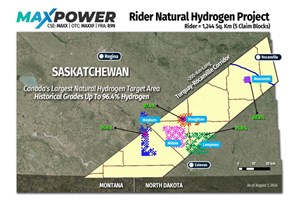News
MAX Power uncovers Canada’s largest natural H2 target area
MAX Power Mining Corp., utilizing proprietary methods and data modelling, has identified a prospective naturally occurring H2 resource play in southeast Saskatchewan featuring dozens of historical H2 showings, including grades up to 96.4%, within a compelling geological context.
As a result, through a series of permit applications, MAX Power has assembled a 1,244 sq. km land package, which shall now be referred to as the “Rider Natural H2 Project”, situated within the ~200-km-long NE-SW striking Torquay-Rocanville Corridor.
Multiple high-priority target areas exist across five separate large claim blocks and include evidence of potential upward migration of H2 to surface, possibly through serpentinization or fracture zones, making the Rider Project the largest known area in Canada for the potential discovery of naturally occurring accumulations of H2 gas. MAX Power’s staking covers almost all of the available Crown land as well as the premier natural H2 targets within the Torquay-Rocanville Corridor.
Highlights
- Two blocks at the Rider Natural H2 Project include very high concentrations of H2 (4% at Weyburn and 87.4% at Stoughton) from the wellhead, supported by historical drill stem tests from old wells, indicating that natural H2 may have migrated to surface
- Two additional high-grade showings (3% and 75.6%) from the wellhead also occur within 800 meters and 200 meters, respectively, of MAX Power land claims
- Given the limited number of wells (45) in the data set covering the Rider Natural H2 Project, vs. the number of total wells believed to have been drilled in the region for which data is not available, the fact that seven of these wells showed H2 grades >10% at varying depths takes on added significance (the other 38 showed H2 grades between 1% and 10%).
MAX Power Special Advisor Mr. Denis Brière, VP-Engineering for Chapman H2 and Petroleum Engineering Ltd., and regarded as one of the world’s leading petrophysicists, said, “My involvement in the world’s first discovery of a naturally occurring H2 gas accumulation in Mali, West Africa, over a decade ago was tremendously gratifying, especially since it quickly powered an entire village with low-cost, emissions-free electricity. This news from Saskatchewan – the scale of the opportunity and the very high historical grades – represents a watershed development for the world in the rapidly emerging natural H2 sector. Chapman is looking forward to working with MAX Power to take the Rider Natural H2 Project to the next level.”


